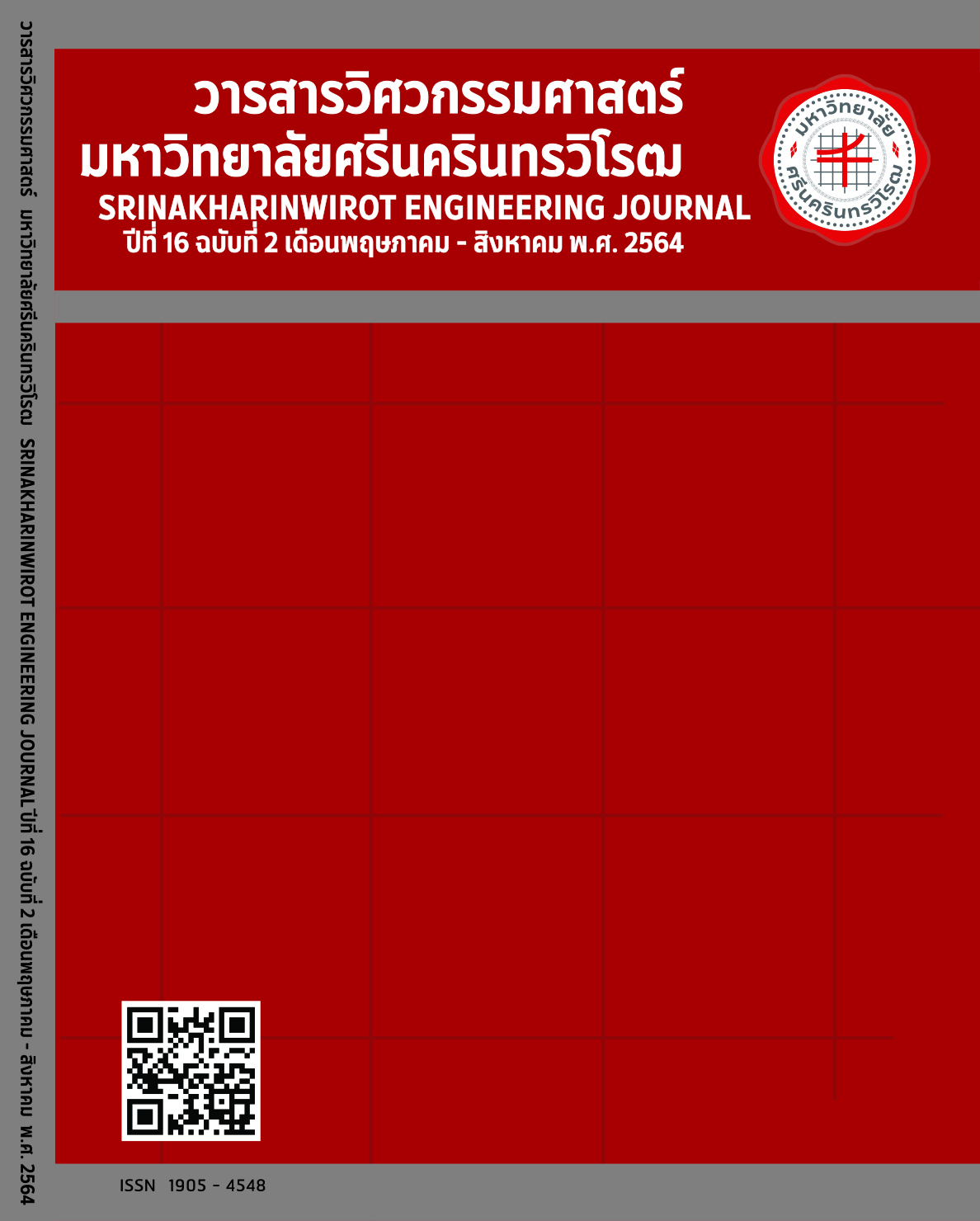Strength, Water Absorption and Chloride Penetration of Mortar in Ternary Blends System with Calcium Carbide Residue and Fly Ash
Main Article Content
Abstract
This research presents to develop ground calcium carbide residue (GCCB) and ground fine fly ash (GFFA) as a cementitious material for blend Portland cement type 1 (CT). CT was partially replaced at 15% of GFFA by weight of cementitious materials. In addition, GCCB, GFFA and CT were used as a ternary blends system in producing mortar. For ternary blends system, CT was partially replaced at 15% of GFFA blend with GCCB at the dosage levels of 5%, at 15% GFFA blend with GCCB at the dosage levels of 15% and at 15% of GFFA blends with GCCB at the dosage levels of 25% by weight of cementitious materials. The ratio of water to cementitious material (W/B) was used constant at 0.48 and the flow test of mortar was also kept between 105-115% with superplasticizer. Compressive strength, water absorption and chloride penetration were investigated. Test results found that the use of 15% of GFFA produced mixes of mortar with good compressive strength. Compressive strength of 15% of GFFA is high at 78-96% in comparison with the CT mortar mixes. However, the water absorption and chloride penetration of mortar with 15% of GFFA+5% of GCCB, 15% of GFFA+15% of GCCB and 15% of GFFA+25% of GCCB mortar is high in comparison with the mortar mixes at 15% of GFFA by weight of cementitious materials.
Article Details

This work is licensed under a Creative Commons Attribution-NonCommercial-NoDerivatives 4.0 International License.
Copyright belongs to Srinakharinwirot University Engineering Journal
References
A. Sathonsaowapark, P. Chindaprasirt and K. Pimraksa, “Workability and strength of lignite bottom ash geopolymer mortar,” J. Harz. Mater., vol. 168, pp. 44-50, 2009.
P. Chindaprasirt, S. Rukzon and V. Sirivivatnanon, “Resistance to chloride penetration of blended Portland cement mortar containing palm oil fuel ash, rice husk ash and fly ash,” Constr. Build. Mater., vol. 22, no.5, pp. 932- 938, 2008.
P. Chindaprasirt and W. Chalee, “Effect of sodium hydroxide concentration on chloride penetration and steel corrosion of fly ash-based geopolymer concrete under marine site,” Constr. Build. Mater., vol. 63, pp. 303-310, 2014.
ASTM C230, “Standard Specification for Flow Table for use in Tests of Hydraulic Cement,” Annual Book of ASTM Standard., vol. 04.01, pp. 206- 211, 2005.
ASTM C109, “Standard Test Method for Compressive Strength of Hydraulic Cement Mortars (Using 2–in or [50 mm] Cube Specimens),” Annual Book of ASTM Standards., Vol. 04.01, pp. 76- 81, 2005.
ASTM C642, “Standard Test Method for Density, Absorption, and Voids in Hardened Concrete,” Annual Book of ASTM Standards., vol. 04.02, pp. 338-340, 2005.
ASTM C39, “Standard Test Method for Compressive Strength of Cylindrical Concrete Specimens,” Annual Book of ASTM Standards., vol. 04.02, 21-27, 2005.
P. Krammart amd S. Tangtermsirikul, “Properties of cement made by parlially replacing cement law materials with municipal solid waste ashes and calcium carbide waste,” Constr. Build. Mater., vol. 18, pp. 579-583, 2004.
N. Makaratat, C. Jaturapitakkul and T. Laosamathikul, “Effects of Calcium Carbide Residue–Fly Ash Binder on Mechanical Properties of Concrete,” J. Mater. Civil Eng., vol. 22, no. 11, pp. 1164-1170, 2010.
ASTM C618. “Standard Specification for Coal Fly Ash and Raw or Calcined Natural Pozzolan for Use as a Mineral Admixture in Concrete,” Annual Book of ASTM Standard., vol. 04.02, pp. 323-325, 2005.
K. Somna, C. Jaturapitakkul and P. Kajitvichyanukul, “Microstructure of Calcium Carbide Residue–Ground fine fly ash Paste,” J. Mater. Civil Eng., vol. 23, no. 3, pp. 298-304, 2010.
A.M. Neville, “Properties of concrete,” 4th and Final Edition, Malaysia: Longman Group Limited, 1995.
S. Rukzon and P. Chindaprasirt, “Strength, Chloride Penetration and Corrosion Resistance of Ternary Blends of Portland Cement Self-compacting Concrete Containing Bagasse Ash and Rice Husk-bark Ash,” Chiang Mai J. Sci., vol. 45, no. 4, pp. 863-1874, 2018.
ASTM C1202, “Standard Test Method for Electrical Indication of Concrete’s Ability to Resist Chloride Ion Penetration,” Annual Book of ASTM Standard., vol. 04.02, pp. 646-651, 2001.


